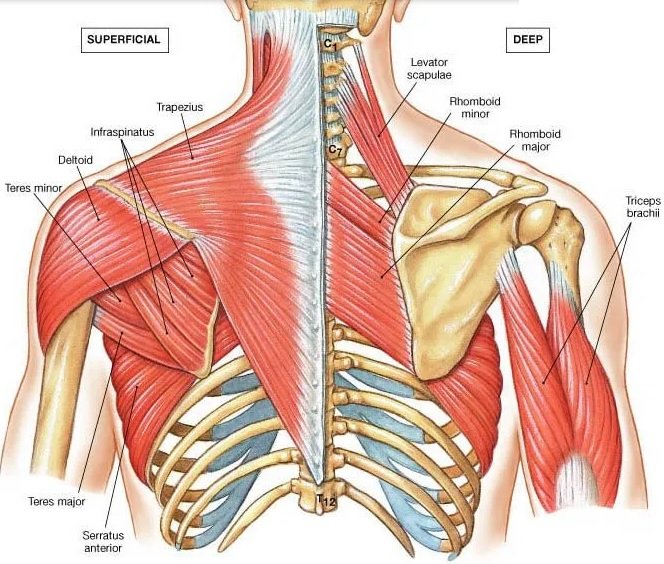Muscles of the Shoulder Region
The muscles of the upper limb (specifically shoulder region) can be categorized as:
Extrinsic muscles - these originate from the trunk and attach to the bones of the shoulder (such as: scapula, humerus, and clavicle). This can be further categorized as superficial and deep muscles:
Superficial - trapezius, and latissimus dorsi
Deep - levator scapulae, rhomboid major, and rhomboid minor
Intrinsic muscles - these originate from the bones of shoulder (specifically: clavicle and scapula) attach to other bones of the shoulder (specifically: humerus). These include the following:
Deltoid
Teres major
Rotator cuff muscles - subscapularis, supraspinatus, infraspinatus, and teres minor
Extrinsic Muscles
Superficial Extrinsic Muscles
Trapezius - The muscle fibres of the trapezius are arranged in a manner that appears trapezoid in shape. This muscle is the most superficial, and lies on either side of the vertebral column.
This muscle originates from the skull, nuchal ligament, and spinous processes of C7-T12 vertebra, and attaches to the spine and acromion of the scapula and the clavicle.
This muscle acts to superiorly rotate and retract the scapula, its upper fibres elevate the scapula while its lower fibres depress the scapula.
This muscle is innervated by the accessory nerve.
Latissimus Dorsi - This muscle covers a large region of the lower back.
This muscle originates from the spinous processes of T7-T12 vertebra, the iliac crest, the last three ribs, and the thoracolumbar fascia and attaches to the intertubercular sulcus of the humerus.
This muscle acts to extend, adduct, and medially rotate the upper limb.
This muscle is innervated by the thoracodorsal nerve.
Deep Extrinsic muscles
Levator Scapulae
This muscle originates from the transverse processes of C1-C4 vertebrae and attaches to the medial border of the scapula.
This muscle acts to elevate the scapula.
This muscle is innervated by the dorsal scapular nerve.
Rhomboid Major - lies inferior to rhomboid minor.
This muscle originates from the spinous processes of T2-T5 vertebrae and attaches to the medial border of the scapula, lying between the spine of the scapula and its inferior angle.
This muscle acts to retract and superiorly rotate the spine.
This muscle is innervated by the dorsal scapular nerve.
Rhomboid Minor - lies superior to rhomboid major.
This muscle originates from the spinous processes of C7-T1 vertebrae and attaches to the medial border of the scapula.
This muscle acts to retract and inferiorly rotate the scapula.
This muscle is innervated by the dorsal scapular nerve.
Intrinsic Muscles
Deltoid
This muscle originates from the lateral third of the clavicle, acromion and spine of the scapula and attaches to the deltoid tuberosity on the humerus.
This muscle acts to flex and medially rotate the arm, extend and laterally rotate the arm, and it is also a major abductor of the arm.
This muscle is innervated by the axillary nerve.
Teres Major
This muscle originates from the posterior surface of the inferior angle of the scapula and attaches to the medial surface of the intertubercular groove of the humerus.
This muscle acts to adduct and extend the arm at the shoulder joint, and it medially rotates the arm.
This muscle is innervated by the lower subscapular nerve.
Rotator Cuff muscles - This group of four muscles originate from the scapula and attach to the head of the humerus, and they provide additional stability to the glenohumeral joint.
Supraspinatus
This muscle originates from the supraspinous fossa of the scapula and attaches to the greater tubercle of the humerus.
This muscle acts to abduct the arm between 0 and 15 degrees and assists the actions of the deltoid muscle.
This muscle is innervated by the suprascapular nerve.
Infraspinatus
This muscle originates from the infraspinous fossa of the scapula and attaches to the greater tubercle of the humerus.
This muscle acts to laterally rotate the arm.
This muscle is innervated by the subscapular nerve.
Subscapularis
This muscle originates from the subscapular fossa and attaches to the lesser tubercle of the humerus.
This muscle acts to medially rotate the arm.
This muscle is innervated by the upper and lower subscapular nerves.
Teres Minor
This muscle originates from the posterior surface of the scapula on its lateral border and attaches to the greater tubercle of the humerus.
This muscle acts to laterally rotate the arm.
This muscle is innervated by the axillary nerve.
Clinical Notes:
The rotator cuff muscles are responsible for stabilizing the glenohumeral joint and ensuring the head of the humerus remains in the glenoid cavity.
The supraspinatus muscle initiates the first fifteen degrees of abduction while the deltoid is responsible for the rest. As such, in the event that the supraspinatus muscle is injured, mechanical movement (by physically tilting) to one side to move the arm about fifteen degrees is necessary such that the deltoid can take over.



